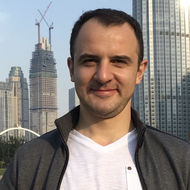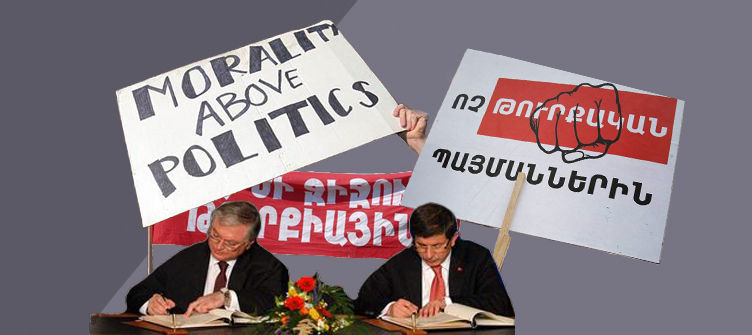Mon Mar 05 2018 · 5 min read
Six Lessons From the Failed Armenian-Turkish Rapprochement

By Vahram Ter-Matevosyan

by the same author
Opening of the Akhalkalak-Kars Railway: What to do Now?
Last week, the Baku-Tbilisi Kars became operational. The Akhalkalak Terminal, is only 30 kilometers from Armenia’s border. What does this mean for Armenia and for the Armenians of Javakhk?
On March 1, 2018, President Serzh Sargsyan, as promised in September 2017, signed a decree announcing the Armenian-Turkish protocols null and void. He thus issued a belated death certificate to a process that was long dead. Now, as the process is legally over, it is time to draw some lessons. Needless to say, this is by no means an exhaustive list.
The first tangible thing that Armenia lost in the process was precious time. Nine invaluable and important years were spent on a ratification process that was doomed to fail from the moment the two protocols were signed in Zurich in October 2009. By late 2009, it was obvious that Turkey’s political leadership had neither the political will nor the willingness to respect its commitments. One could argue that in April 2010, when Armenia’s president halted the ratification process of the protocols, the process was already dead. In spite of this, for years Armenia’s political leadership harbored unsubstantiated hopes that one day Turkey would reverse its stance and ratify the protocols; those years could have been used in exploring other options. Hence, lesson number one: Next time Armenia launches a process with Turkey, the exit strategy should be as important and timely as the initiation of it.
The second issue has to do with the methodological error that Armenia agreed to tolerate in the process. Two protocols signed in 2009 aimed at addressing two complex problems simultaneously – normalization of relations and reconciliation of two nations. As I have elaborated on this elsewhere, it was a mistake that cost dearly for the entire endeavor. Combining these two parallel, and the same time, complex and strongly intertwined processes into one initiative had a limited chance of success. Normalization of interstate relations requires political commitment and unreserved will of a state’s leadership. A single document composed of a few lines on establishing diplomatic relations would be enough to initiate the normalization process. That would require no ratification in parliament, no political bargaining, no big domestic political debates. Whereas, reconciliation requires a constantly different toolbox where the state has no role to play other than facilitation. A reconciliation process can take years if not decades, hence, it is up to civil societies to initiate and lead that process. Hence, lesson number two: Next time when Armenia launches a process with Turkey, the process of normalization of interstate relations should be disentangled from the reconciliation process.
International mediation efforts are important to break the deadlock. Switzerland and the U.S. played a significant role during the Armenian-Turkish rapprochement. A process that started a few years earlier and was commonly dubbed “football diplomacy,” was immensely supported by the U.S. Of course, the mood in Turkey was totally different back then than is the case now. In spite of strong differences on certain regional matters, the U.S. took one of the leading roles on its shoulders and Turkey did not resist, at least in the initial stage. Switzerland devotedly facilitated the process of preparing the protocols. Other international stakeholders were also largely supportive. By being present during the signing ceremony in Zurich and by conveying their congratulations to the foreign ministers of Armenia and Turkey, most of them assumed that their mission was over. As we came to observe at later stages, other than the U.S., other states and international institutions only rarely recalled the Zurich protocols. Their support was at best fragmental. Hence, lesson number three: Next time Armenia launches a process with Turkey it should seek international support not only during the process leading to the signing of any document but also during the implementation phase of any agreement.
When the formal part of the process was initiated in 2008, there were divergent voices in Turkey. Some supported the process, while others were staunchly against it, yet many remained skeptical and suspicious. A number of intellectuals and opinion makers in Turkey supported the process seeing the closed border as an anachronism. A number of supporting articles appeared in the Turkish media, which raised opinions different from nationalistic and pro-Azerbaijani voices. Some conservative voices and supporters of the AKP (Justice and Development Party) were also supportive of the process. However, as the process moved on, the number of supporters in Turkish society declined. The problems with free speech and crushing dissent in Turkey also played no minor role in silencing those left wing and liberal intellectuals, who supported the process. Hence, lesson number four: Next time Armenia launches a process with Turkey it should also work with public opinion makers in Turkey.
By and large, Armenian society supported the diplomatic initiative in 2009. The government concentrated on those parts of the protocols which primarily aimed to normalize relations and open the borders, while many formulations and aspects of the protocols were problematic. The ARF left the ruling coalition in April 2009 because of diverging views with the ruling RPA on the ongoing process of Armenian-Turkish negotiations. As it was revealed later, the formulations concerning the mutual recognition of borders and establishing a subcommittee of historical dimensions were some of those points which sent waves of uncertainty through many layers of the Armenian nation. Many in Armenia and the Diaspora were not pleased with the fact that the Armenian side yielded its previous position and agreed to establish a (sub)committee which would allegedly look into the past and establish the truth. Some people also interpreted that inclusion as a tactical move on the Armenian side to keep Turkey in the process, others interpreted it as a manipulation. In Turkey, it was seen as both face-saving and a momentous formulation. Hence, lesson number five: Take lesson number two seriously. However, for the sake of clarity: the Armenian Genocide is a political issue and not a matter of historical debate. Hence, playing with words and formulations related to historical events may have undesired implications.
In spite of closed borders, the people of Armenia and Turkey are engaged in different trade and cultural relations. They interact, build connections, develop relations and co-operate independent of non-existent diplomatic relations. Many Armenian citizens live, work and study in Turkey, some legally, while many have problems with authorities for violating Turkish laws and procedures. Because of lack of official documents, many young Armenian children in Turkey are deprived of formal education. Quite many simple and, at the same time, easy-to-solve questions related to Armenian citizens remain unaddressed because of the lack of diplomatic relations. Human lives and humanitarian issues matter and they should not be held hostage to inter-state differences. Hence, lesson number six: The lack of diplomatic relations should not hinder Armenia from exploring other alternative avenues in finding solutions to a number of practical questions of humanitarian nature.


